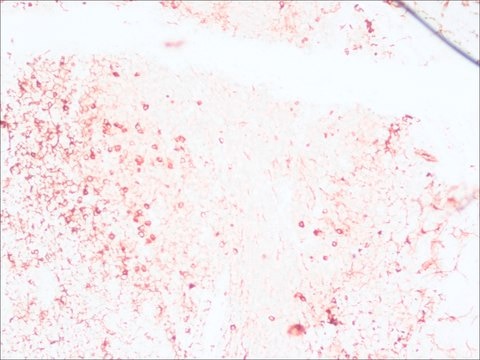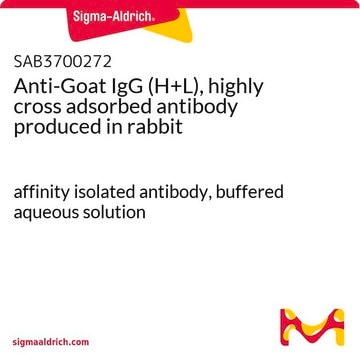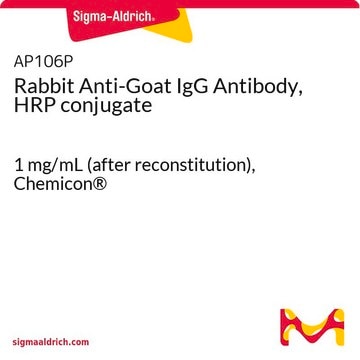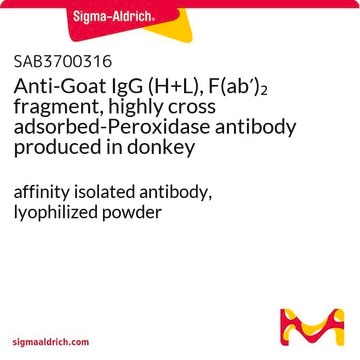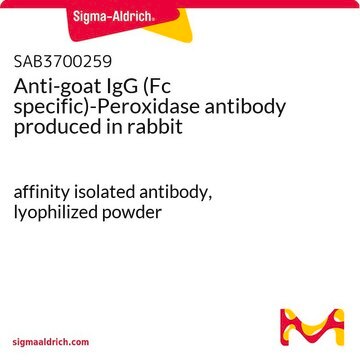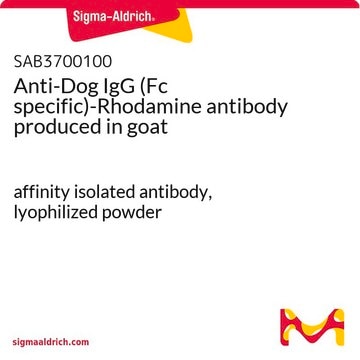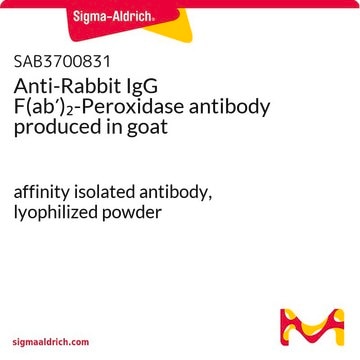SAB3700248
Anti-Goat IgG F(ab′)2-Peroxidase antibody produced in rabbit
affinity isolated antibody, lyophilized powder
Synonym(s):
HRP
Sign Into View Organizational & Contract Pricing
All Photos(1)
About This Item
UNSPSC Code:
12352203
NACRES:
NA.46
Recommended Products
biological source
rabbit
Quality Level
conjugate
peroxidase conjugate
antibody form
affinity isolated antibody
antibody product type
secondary antibodies
clone
polyclonal
form
lyophilized powder
species reactivity
goat
technique(s)
immunohistochemistry: suitable
indirect ELISA: suitable
western blot: suitable
shipped in
wet ice
storage temp.
2-8°C
target post-translational modification
unmodified
Related Categories
General description
Immunoglobulin G (IgG) is part of the immunoglobulin family and is a widely expressed serum antibody. It consists of a γ heavy chain in the constant (C) region. The monomeric 150 kDa structure of IgG constitutes two identical heavy chains and two identical light chains with molecular weight of 50 kDa and 25 kDa respectively. The primary structure of this antibody also contains disulfide bonds involved in linking the two heavy chains, linking the heavy and light chains and resides inside the chains. IgG is further subdivided into four classes namely, IgG1, IgG2, IgG3, and IgG4 with different heavy chains, named γ1, γ2, γ3, and γ4, respectively. Limited digestion using papain cleaves the antibody into three fragments, two of which are identical and contain the antigen-binding activity. They are known as fragment antigen binding (Fab) fragments. These fragments contain the light chains paired with the VH and CH1 domains of the heavy chains.
Specificity
This product was prepared from monospecific antiserum by immunoaffinity chromatography using Goat IgG coupled to agarose beads. Assay by immunoelectrophoresis resulted in a single precipitin arc against Anti-Peroxidase, Anti-Rabbit Serum, Goat IgG, Goat IgG F(ab′)2 and Goat Serum. No reaction was observed against Goat IgG F(c).
Immunogen
Goat IgG F(ab′)2 fragment
Physical properties
Antibody format: IgG
Physical form
Supplied in 0.02 M Potassium Phosphate, 0.15 M Sodium Chloride, pH 7.2 with 10 mg/mL Bovine Serum Albumin (BSA) - Immunoglobulin and Protease free
Reconstitution
Reconstitute with 1.0 mL deionized water (or equivalent).
Disclaimer
Unless otherwise stated in our catalog or other company documentation accompanying the product(s), our products are intended for research use only and are not to be used for any other purpose, which includes but is not limited to, unauthorized commercial uses, in vitro diagnostic uses, ex vivo or in vivo therapeutic uses or any type of consumption or application to humans or animals.
Not finding the right product?
Try our Product Selector Tool.
Certificates of Analysis (COA)
Search for Certificates of Analysis (COA) by entering the products Lot/Batch Number. Lot and Batch Numbers can be found on a product’s label following the words ‘Lot’ or ‘Batch’.
Already Own This Product?
Find documentation for the products that you have recently purchased in the Document Library.
Janeway CA, et al.
Immunobiology: The Immune System in Health and Disease (2005)
Sameh Magdeldin et al.
Stem cell reviews, 10(4), 561-572 (2014-05-07)
Embryonic stem cells (ESCs) have the ability to self-renew indefinitely and they can give unlimited source of cells and tissues for cellular therapies. Recently, the natriuretic peptide receptor A (NPR-A) has been recognized as an important regulator for the self-renewal
Kyunghee Byun et al.
PloS one, 9(8), e104699-e104699 (2014-08-21)
Alcohol is a neurotoxic agent, since long-term heavy ingestion of alcohol can cause various neural diseases including fetal alcohol syndrome, cerebellar degeneracy and alcoholic dementia. However, the molecular mechanisms of alcohol-induced neurotoxicity are still poorly understood despite numerous studies. Thus
Antibody structure, instability, and formulation.
Wang W
Journal of Pharmaceutical Sciences, 96(1), 1-26 (2007)
Olivier Simard et al.
Human mutation, 35(11), 1280-1284 (2014-08-20)
Transient DNA breaks and evidence of DNA damage response have recently been reported during the chromatin remodeling process in haploid spermatids, creating a potential window of enhanced genetic instability. We used flow cytometry to achieve separation of differentiating spermatids into
Our team of scientists has experience in all areas of research including Life Science, Material Science, Chemical Synthesis, Chromatography, Analytical and many others.
Contact Technical Service